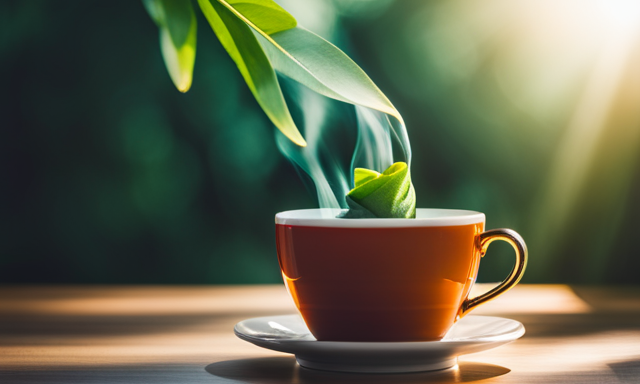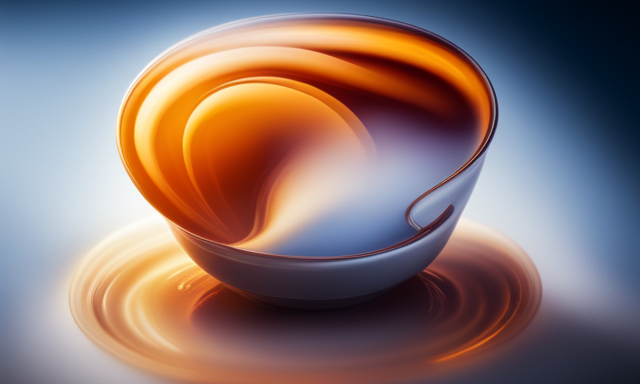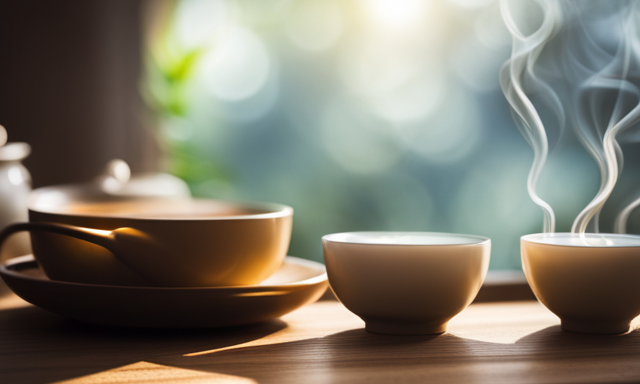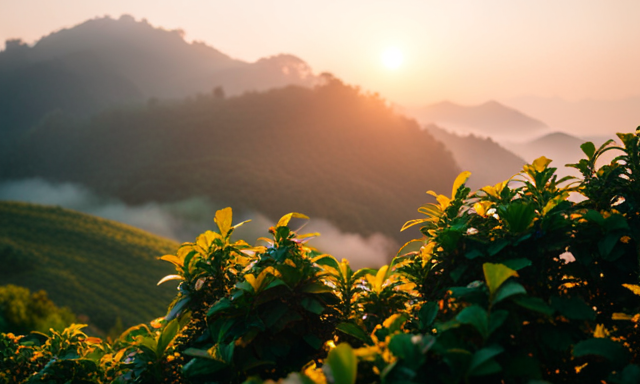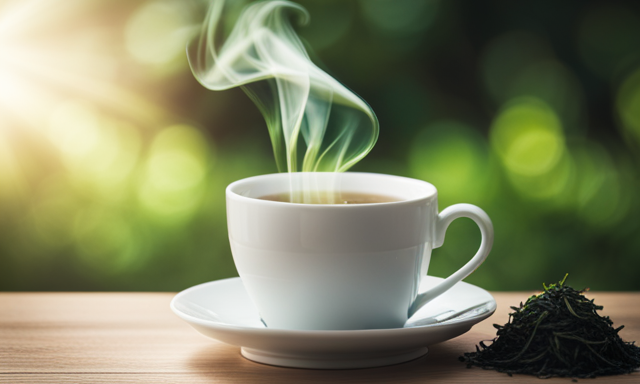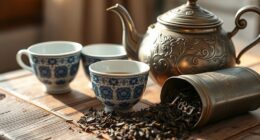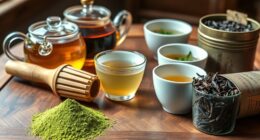I’ve always been curious about the caffeine content in different types of tea. Recently, I stumbled upon the question of how caffeinated oolong tea really is. As a tea enthusiast, this piqued my interest, and I decided to delve into the topic and find some answers.
In this article, we will explore the caffeine levels in oolong tea and compare them to other types of tea. We’ll also discuss the factors that can affect the caffeine content in oolong tea and how to brew it to achieve the desired level of caffeine.
Additionally, we’ll explore the health benefits of oolong tea and how it can be enjoyed as an energizing beverage.
So if you’ve ever wondered about the caffeination of oolong tea, stay tuned as we uncover the truth behind this popular tea variety.
Key Takeaways
- Sensitivity to caffeine in oolong tea varies among individuals, with some experiencing stronger effects and others metabolizing caffeine more efficiently.
- Oolong tea is an energizing beverage that provides a natural boost of energy and can be enjoyed as an alternative to artificial stimulants.
- Proper brewing techniques for oolong tea include using water at 190-200°F and steeping the leaves for 3-5 minutes to achieve a balanced flavor.
- Oolong tea offers a variety of flavors, from floral to fruity, allowing for a diverse and enjoyable taste experience.
What is Oolong Tea?
If you’ve never tried oolong tea, you’re missing out on a delicious and invigorating beverage. Oolong tea combines the rich flavors of black tea with the delicate notes of green tea. It is a traditional Chinese tea that undergoes a unique oxidation process, which gives it a distinct taste and aroma.
This process involves partially fermenting the tea leaves. First, the leaves are allowed to wither in the sun. Then, they are oxidized before being dried. The amount of oxidation determines the flavor profile of the tea, ranging from light and floral to dark and robust.
In terms of caffeine content, oolong tea falls somewhere between black tea and green tea. It contains about 30-50 milligrams of caffeine per cup.
Now, let’s delve into the fascinating world of the oxidation process of oolong tea.
The Oxidation Process of Oolong Tea
During the oxidation process, the leaves of Oolong tea can darken by up to 50%. This process is crucial in determining the flavor and aroma of the tea.
To understand the oxidation process, imagine the leaves undergoing a series of chemical reactions that release natural enzymes. These enzymes react with oxygen in the air, causing the leaves to gradually turn darker in color. The darker the leaves become, the more oxidized they are.
This oxidation process is carefully monitored and controlled by tea masters to achieve the desired level of oxidation.
The caffeine levels in Oolong tea can also be affected by the oxidation process, as some of the caffeine content may be broken down or altered during this stage.
As we move into the subsequent section about caffeine content in oolong tea, we will explore how the oxidation process influences the final caffeine levels in the tea.
Caffeine Content in Oolong Tea
Oolong tea possesses a natural energy boost that can make it a great alternative to coffee. Many people are curious about the caffeine content in oolong tea and how it affects their bodies. Understanding caffeine metabolism is essential to comprehend the effects it has on our system. The caffeine content in oolong tea can vary depending on factors such as the type of tea leaves, brewing time, and water temperature. To give you an idea of the caffeine levels, here’s a table that compares the approximate caffeine content in different teas:
| Tea Type | Caffeine Content (per 8 oz) |
|---|---|
| Oolong | 30-50 mg |
| Green | 20-45 mg |
| Black | 40-70 mg |
It’s important to note that individual responses to caffeine can vary, and some people may experience caffeine withdrawal symptoms if they suddenly reduce their intake. Moving forward, let’s explore and compare caffeine levels in different types of tea.
Comparing Caffeine Levels in Different Types of Tea
Let’s dive into the fascinating world of tea and discover how different types of this beloved beverage compare when it comes to their caffeine levels.
When it comes to caffeine content in tea, green tea is known to have a lower amount compared to oolong tea. On average, a cup of green tea contains about 20-45 milligrams of caffeine, while a cup of oolong tea can have anywhere between 30-50 milligrams.
To put things into perspective, coffee typically contains around 95 milligrams of caffeine per cup. So, while oolong tea does contain caffeine, it is still considered a milder option compared to coffee.
Now that we’ve explored the caffeine levels in different types of tea, let’s move on to the factors that affect caffeine content in oolong tea.
Factors That Affect Caffeine Content in Oolong Tea
One key factor that influences the amount of caffeine in oolong tea is the duration of steeping. The longer you steep the tea, the more caffeine it will contain. This is because caffeine is extracted from the tea leaves during the steeping process.
The temperature of the water used for steeping can also affect caffeine content. Higher temperatures tend to extract more caffeine from the leaves.
Additionally, the quality and type of tea leaves used can impact the caffeine levels in oolong tea. Younger leaves generally have higher caffeine content compared to older leaves.
Understanding these factors affecting caffeine absorption and the role of steeping time in caffeine content can help you control the caffeine levels in your oolong tea.
Transitioning into the subsequent section about how caffeine affects the body, it is important to note that the amount of caffeine consumed can have various effects on individuals.
How Caffeine Affects the Body
The impact of caffeine on the body can be seen through its various effects and reactions. When we consume caffeine, our body goes through a process called caffeine metabolism. This is where the caffeine is broken down and eliminated from our system.
The speed at which this happens can vary from person to person, but generally, it takes about 3 to 5 hours for half of the caffeine to be eliminated.
It is important to note that excessive caffeine consumption can lead to caffeine withdrawal symptoms, such as headaches, irritability, and fatigue, when you suddenly stop or reduce your caffeine intake. These symptoms can last for a few days until your body adjusts.
Transitioning into the subsequent section about the health benefits of oolong tea, it is fascinating to see how caffeine affects our body, but oolong tea has much more to offer in terms of overall well-being.
Health Benefits of Oolong Tea
Oolong tea, with its unique blend of antioxidants and polyphenols, has been shown to boost metabolism and aid in weight loss. It also contains compounds that can help lower cholesterol levels and reduce the risk of heart disease.
Additionally, oolong tea is known for its ability to improve digestion and promote healthy skin. When brewed properly, oolong tea can offer these health benefits while still providing a moderate amount of caffeine.
In the next section, I will explain how to brew oolong tea for the desired caffeine level.
How to Brew Oolong Tea for the Desired Caffeine Level
Get ready to brew your perfect cup of oolong goodness with just the right amount of pep! When it comes to brewing oolong tea, there are a few techniques you can use to control the caffeine level.
The most important factor is the steeping time. The longer you steep the leaves, the more caffeine will be extracted. If you prefer a lower caffeine content, try steeping for a shorter amount of time, around 2-3 minutes.
Another technique is to use cooler water, as higher temperatures can extract more caffeine. Aim for water around 180-190°F (82-88°C) to keep the caffeine level moderate.
By adjusting these brewing techniques, you can enjoy a cup of oolong tea that suits your desired caffeine level.
Now, let’s dive into the fascinating topic of caffeine sensitivity and oolong tea.
Caffeine Sensitivity and Oolong Tea
When it comes to brewing oolong tea, it’s important to consider your desired caffeine level. In my previous subtopic, I discussed how to brew oolong tea to achieve the caffeine level you want. Now, let’s delve into the topic of caffeine sensitivity and oolong tea. Understanding your caffeine tolerance and metabolism can help you better appreciate the effects of oolong tea on your body. Some individuals may be more sensitive to caffeine and may experience stronger stimulant effects, while others may metabolize caffeine more efficiently. This knowledge allows you to adjust your oolong tea consumption accordingly, ensuring a balanced and enjoyable experience. So, let’s explore how oolong tea can energize you and enhance your day without relying on artificial stimulants.
Enjoying Oolong Tea as an Energizing Beverage
Indulge in the invigorating embrace of oolong tea, letting its vibrant essence dance on your taste buds and awaken your senses like a symphony of flavor. Oolong tea is not only a delightful beverage, but it can also provide a natural energy boost.
To truly enjoy oolong tea as an energizing beverage, it is important to master the proper brewing techniques. When brewing oolong tea, use water that is around 190-200°F and steep the leaves for 3-5 minutes. This will ensure a perfect balance of flavors and a caffeine kick that will keep you going throughout the day.
Oolong tea comes in a variety of flavors, from floral to fruity, and its complexity makes it a fascinating choice for tea enthusiasts. So, explore the world of oolong tea and savor the energizing experience it offers.
- Experiment with different brewing times and water temperatures to find your perfect cup of oolong tea.
- Try different oolong tea flavors like Tie Guan Yin, Da Hong Pao, or Oriental Beauty to discover your favorite.
- Don’t be afraid to add a touch of honey or lemon to enhance the flavors of your oolong tea.
Frequently Asked Questions
Can I drink oolong tea if I am sensitive to caffeine?
I would recommend avoiding oolong tea if you are sensitive to caffeine. However, there are plenty of alternative caffeine-free teas available such as herbal teas, rooibos tea, and chamomile tea.
Does the caffeine content in oolong tea vary depending on the brewing method?
The caffeine content in oolong tea can vary depending on the brewing techniques used. Different methods can result in varying caffeine levels, making it difficult to determine an exact amount.
What are the potential side effects of consuming too much caffeine from oolong tea?
Potential health risks of consuming too much caffeine from oolong tea include insomnia, restlessness, increased heart rate, and digestive issues. Long-term effects may include tolerance, dependence, and potential negative impacts on cardiovascular health and sleep patterns.
Are there any tips for maximizing the energizing effects of oolong tea?
To maximize the energizing effects of oolong tea, timing consumption is key. It’s best to drink it in the morning or early afternoon to take advantage of its natural caffeine content and avoid any sleep disturbances.
Can oolong tea be consumed in the evening without disrupting sleep?
Oolong tea can be consumed in the evening without disrupting sleep. Its moderate caffeine content won’t keep you awake, and it contains L-theanine which promotes relaxation and better sleep quality.
Conclusion
In conclusion, oolong tea offers a moderate amount of caffeine, making it a great choice for those seeking a gentle energy boost.
With its unique oxidation process, oolong tea strikes a perfect balance between black and green teas in terms of both flavor and caffeine content.
Whether you’re a caffeine lover or just looking for a healthier alternative to coffee, oolong tea has you covered.
So why not indulge in a cup of this delightful beverage and experience its numerous health benefits?
Cheers to a revitalizing and satisfying tea experience!

